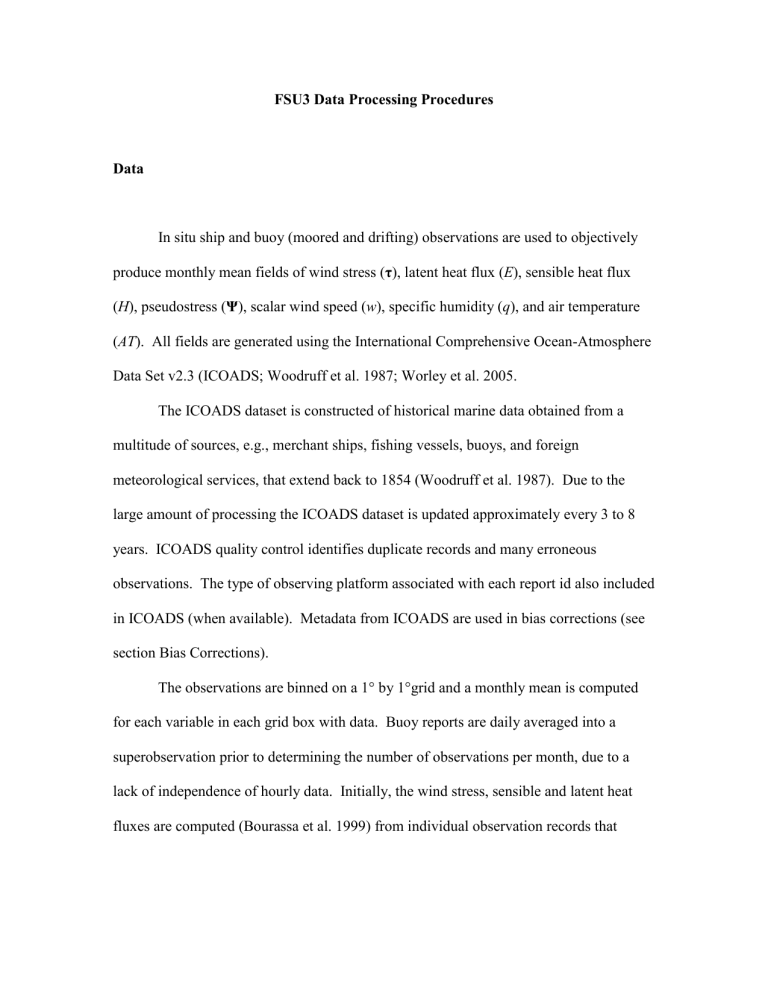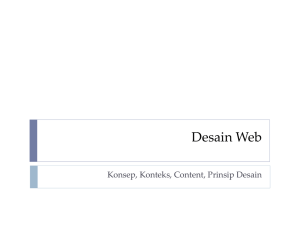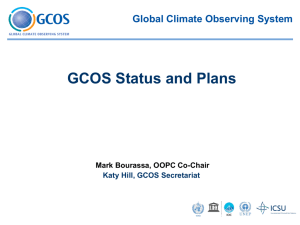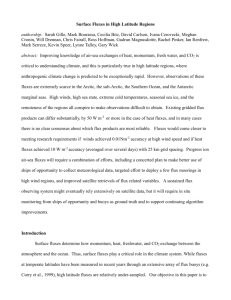FSU3_Data_Processing_Procedures

FSU3 Data Processing Procedures
Data
In situ ship and buoy (moored and drifting) observations are used to objectively produce monthly mean fields of wind stress (
τ
), latent heat flux ( E ), sensible heat flux
( H ), pseudostress ( Ψ ), scalar wind speed ( w ), specific humidity ( q ), and air temperature
( AT ). All fields are generated using the International Comprehensive Ocean-Atmosphere
Data Set v2.3 (ICOADS; Woodruff et al. 1987; Worley et al. 2005.
The ICOADS dataset is constructed of historical marine data obtained from a multitude of sources, e.g., merchant ships, fishing vessels, buoys, and foreign meteorological services, that extend back to 1854 (Woodruff et al. 1987). Due to the large amount of processing the ICOADS dataset is updated approximately every 3 to 8 years. ICOADS quality control identifies duplicate records and many erroneous observations. The type of observing platform associated with each report id also included in ICOADS (when available). Metadata from ICOADS are used in bias corrections (see section Bias Corrections).
The observations are binned on a 1° by 1°grid and a monthly mean is computed for each variable in each grid box with data. Buoy reports are daily averaged into a superobservation prior to determining the number of observations per month, due to a lack of independence of hourly data. Initially, the wind stress, sensible and latent heat fluxes are computed (Bourassa et al. 1999) from individual observation records that
contain wind speed and direction, air temperature, specific humidity, and sea surface temperature. The surface fluxes are also averaged monthly on the same 1° by 1° grid.
The National Meteorological Center’s (NMC) blended sea surface temperature analysis (referred to as Reynolds SSTs hereafter; Reynolds 1988) is used to compute the sensible heat flux during the variational method. The use of the blended product is due to the fact that bias corrections for ship based sea surface temperatures are not well understood and vary greatly on a ship to ship basis. The blended analysis merged the
NMC’s in situ sea surface temperature product with their satellite analysis. The blending procedure utilized the in situ analysis for regions of high density in situ observations whereas the satellite analysis was used for regions containing an insufficient amount of in situ data. Reynolds (1988) showed that the satellite analysis has little influence on the blended fields from 60°N to the equator in the Atlantic Ocean due to the large quantity of in situ observations. For this region the calculated fluxes are similar to those calculated with the Reynolds SSTs.
Bias Corrections
Prior to the calculation of the wind stress and surface heat fluxes, known systematic errors are removed from the data. Air temperature measurements from
Voluntary Observing Ships (VOS) and buoys are known to contain systematic biases associated with the heating of the ship’s infrastructure and instruments by solar radiation
(Berry et al. 2004). To compute surface fluxes to within 10 Wm
-2
, the air temperature should be measured to an accuracy of ±0.2°C (Taylor et al. 2000). The error in air
temperature measurements associated with solar heating can be greater than 0.2°C and larger than the air/sea temperature difference, thus resulting in inaccurate surface flux calculations (Berry et al. 2004). Since the sensible heat flux is directly dependent on the air/sea temperature difference, the air temperature bias can produce an unrealistic transfer of heat. In addition, the momentum and heat fluxes are also dependent on the atmospheric stability via the transfer coefficients; therefore unrealistic stable or nearneutral conditions caused by the air temperature error can result in a reduced magnitude of the surface fluxes. In order to remove the radiative heating errors from the VOS observations a heat budget model developed by Berry et al. (2004) was applied to the monthly averaged data using 30 Wm
-2
to represent the monthly mean solar heating.
The surface fluxes are regulated by the interaction of the sea surface and overlying atmospheric conditions, thus the Reynolds SSTs must be corrected to represent a skin temperature. The skin temperature is sensitive to local changes in heat and momentum fluxes; therefore the bulk minus skin temperature difference is highly variable on short time scales and dependent on latitude (Donlon and Robinson 1997).
Overall, Donlon and Robinson (1997) calculated a mean bulk minus skin temperature difference of 0.35 K±0.35 K. As a result, a value of 0.3°C is added to the monthly mean
Reynolds SSTs.
Visually estimated (Beaufort) winds are converted to a 10 m wind speed value using the Lindau (1995) “Beaufort equivalent scale”. The anemometer wind speed observations are height adjusted to a standard height of 10 m using a surface flux model
(Bourassa et al. 1999). Ship anemometer observations are presumed to correspond to a 20 m reference height whereas buoy anemometer heights are known. The assumption of a
constant reference height introduces errors and a trend due to the increasing measurement heights with time. However, the detailed metadata required to accurately height adjust the ship wind speed observations are only available from the mid 1990s. Using the limited metadata would add a substantial discontinuity to the dataset.
Quality Control
Three quality control procedures are implemented to remove erroneous and non- representative observations from the data sets. The first quality control procedure is applied to the individual observations; whereas the remaining two are implemented on the monthly mean gridded fields. First, the individual observations are compared to climatological values. A monthly mean and standard deviation are computed using the daSilva climatology (daSilva et al. 1994). Data that fall outside 3.5 standard deviations from the monthly mean are eliminated. In addition, a minimum standard deviation for each variable is also imposed due to the limited variability of the deSilva climatology in certain regions of the globe (Bourassa et al. 2005). This comparison removes very few observations, most of which are grossly inconsistent with nearby observations. For the 26 years of data that have been examined, no clusters of data have been removed; indicating that this comparison has not caused excessive trimming.
The second quality control procedure termed “auto-flag” is applied to the monthly mean gridded ship observations. This process flags and removes grid points that differ too much from adjacent points. The auto-flag routine computes differences between
nearest neighboring grid boxes for each scalar variable: air temperature, sea surface temperature, specific humidity, wind speed, and u and v pseudostress components.
Differences in adjacent grid boxes are (on average) larger in regions with greater natural variability. Local monthly variabilities are estimated as standard deviations of a five year average (1999-2003) of 6 hourly European Centre for Medium-Range Weather Forecasts
(ECMWF) reanalyses. The absolute value of each difference is divided by the square root of the standard deviation to account for regional variability. Subjective analysis of the fields indicated that this procedure was quite effective in removing regional biases in the quality control technique. These adjusted differences are ordered by magnitude and the grid boxes associated with the top three percent of the greatest differences receive flags. A datum is removed (set equal to a designated missing value) based on the total number of flags a particular grid box receives for that variable. Air temperature, sea surface temperature, and specific humidity are removed (on a variable by variable basis) if a grid box contains five or more flags for that variable. Wind speed data are removed if a grid box contains four or more flags. Lastly, if in three or more of the scalar variables an individual grid box was set to missing, then the grid cell and associated data are completely eliminated from that particular month’s data set. Tests were again made to verify that this approach did not remove clusters of data. The FSU3 fluxes are the first version of the FSU winds to employ the auto-flag technique. Doing so has reduced the human component of processing time by approximately a factor of ten.
The third quality control procedure utilizes a tool developed to display the monthly mean gridded ship and buoy observations. An analyst visually inspects the monthly in situ fields and subjectively removes suspect data that were not eliminated by
the preceding quality control methods. The edits are made in data sparse regions, where the auto-flag procedure cannot effectively be applied. Very few data are removed in this step, which is the most time intensive as it is not automated.
References
Berry, D. I., E. C. Kent, and P. K. Taylor, 2004: An Analytical Model of Heating Errors in Marine Air Temperature for Ships. J. Atmos. Oceanic Technol.
, 21 , 1198-1215.
Bourassa, M. A., D. G. Vincent, and W. L. Wood, 1999: A Flux Parameterization
Including the Effects of Capillary Waves and Sea State. Journal of the Atmospheric
Sciences , 56 , 1123-1139.
―, M. A., R. Romero, S. R. Smith, and J. J. O’Brien, 2005: A New FSU Winds
Climatology. J. Climate , 18 , 3686-3698. da Silva, A., A. C. Young, and S. Levitus, 1994: Algorithms and Procedures . Vol. 1,
Atlas of Surface Marine Data 1994, NOAA Atlas NESDIS 6, 83 pp.
Donlon, C. J. and I. S. Robinson, 1997: Observations of the Oceanic Thermal Skin in the
Atlantic Ocean. J. Geophys. Res.
, 102 , 18585-18606.
Lindau, R., 1995: A new Beaufort equivalent scale. Proc. Int. COADS Winds Workshop ,
Kiel, Germany, Institut für Meereskunde Kiel and NOAA, 232–252
Reynolds, R. W., 1988: A Real-Time Global Sea Surface Temperature Analysis. J.
Climate , 1 , 75-86.
Taylor, P. K., and WCRP/SCOR Working Group on Air-Sea Fluxes, 2000:
Intercomparison and Validation of Ocean-Atmosphere Energy Flux Fields
(November 2000). WMO/TD No. 1036, 306 pp.
Woodruff, S. D., R. J. Slutz, R. L. Jenne, and P. M. Steurer, 1987: A Comprehensive
Ocean-Atmosphere Data Set. Bull. Amer. Meteor. Soc.
, 68 , 1239-1250.
―, S. D., H. F. Diaz, J. D. Elms, and S. J. Worley, 1998: COADS Release 2 Data and
Metadata Enhancements for Improvements of Marine Surface Flux Fields. Phys.
Chem. Earth , 23 , 517-526.
Worley, S. J., S. D. Woodruff, R. W. Reynolds, S. J. Lubker, and N. Lott, 2005: ICOADS
Release 2.1 Data and Products. Int. J. Climatol.
, 25 , 823-842.











